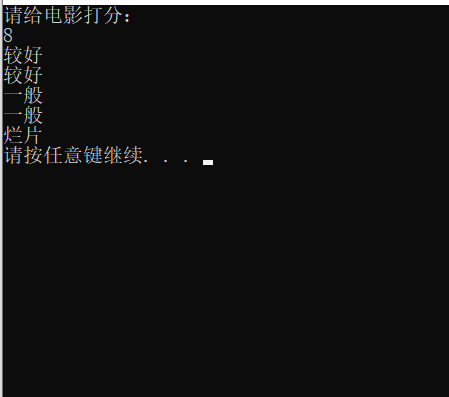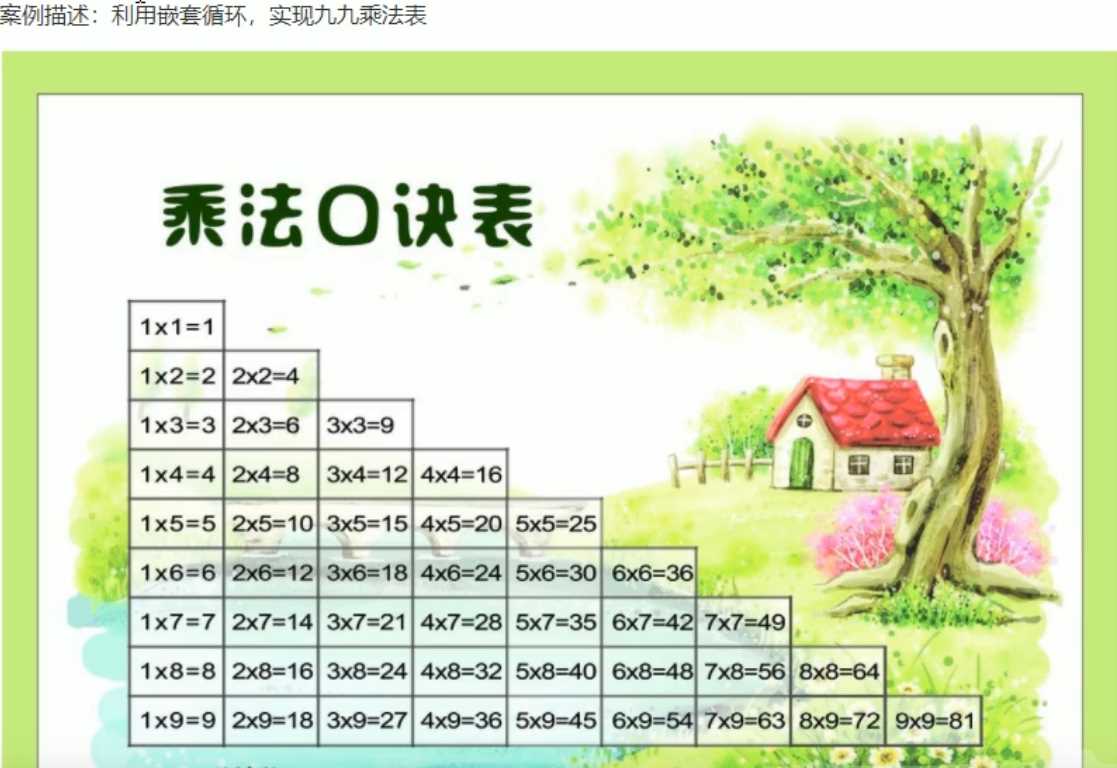这篇文章主要介绍了C++的程序流程结构是什么的相关知识,内容详细易懂,操作简单快捷,具有一定借鉴价值,相信大家阅读完这篇C++的程序流程结构是什么文章都会有所收获,下面我们一起来看看吧。
前言
C/C++支持最基本的三种程序运行结构:顺序结构、选择结构、循环结构。

顺序结构就是顺着写代码,不想多说。
1 选择结构
1.1 if语句(和C没啥不一样)
作用:执行满足条件的语句
if语句的三种形式:
单行格式if语句
语法:
if(条件){条件满足执行的语句}#include<iostream>using namespace std;int main(){//用户输入分数,如果分数大于600,视为考上一本大学,在屏幕上输出//1.用户输入分数int score = 0;cout << "请输入一个分数:" << endl;cin >> score;cout << "您输入的分数为:" << score << endl;//2.判断if (score > 600){cout << "恭喜您考上了一本大学" << endl;}system("pause");return 0;}多行格式if语句
语法:
if(条件){条件满足执行的语句}else{条件不满足执行的语句}#include<iostream>using namespace std;int main(){//1.用户输入分数int score = 0;cout << "请输入一个分数:" << endl;cin >> score;cout << "您输入的分数为:" << score << endl;//2.判断if (score > 600){cout << "恭喜您考上了一本大学" << endl;}else{cout << "您没有考上一本大学,请再接再厉" << endl;}system("pause");return 0;}多条件的if语句
语法:
if(条件1){条件1满足执行的语句}else if(条件2){条件2满足执行的语句}... else{都不满足执行的语句}#include<iostream>using namespace std;int main(){//1.用户输入分数int score = 0;cout << "请输入一个分数:" << endl;cin >> score;cout << "您输入的分数为:" << score << endl;//2.判断if (score > 600){cout << "恭喜您考上了一本大学" << endl;}else if (score > 500){cout << "恭喜您考上了二本大学" << endl;}else if (score > 400){cout << "恭喜您考上了三本大学" << endl;}else{cout << "您没有考上一本大学,请再接再厉" << endl;}system("pause");return 0;}嵌套if语句:在if语句中嵌套使用if语句,达到更精确的条件判断
#include<iostream>using namespace std;int main(){//1.用户输入分数int score = 0;cout << "请输入一个分数:" << endl;cin >> score;cout << "您输入的分数为:" << score << endl;//2.判断if (score > 600){if (score > 1000) { cout << "恭喜您考到了地球之外" << endl; }if (score > 800) { cout << "恭喜您考到了清北" << endl; }else { cout << "恭喜您考上了普通一本大学" << endl; }}else if (score > 500){cout << "恭喜您考上了二本大学" << endl;}else if (score > 400){cout << "恭喜您考上了三本大学" << endl;}else{cout << "您没有考上一本大学,请再接再厉" << endl;}system("pause");return 0;}
#include<iostream>using namespace std;int main(){int num1 = 0;int num2 = 0;int num3 = 0;//用户输入cout << "请输入小猪A的体重:" << endl;cin >> num1;cout << "请输入小猪B的体重:" << endl;cin >> num2;cout << "请输入小猪C的体重:" << endl;cin >> num3;cout << "小猪A的体重为:" << num1 << endl;cout << "小猪B的体重为:" << num2 << endl;cout << "小猪C的体重为:" << num3 << endl;//判断if (num1 > num2) //A>B{if (num1 > num3) //A>C {cout << "\n小猪A最重" << endl;}else //C>A{cout << "\n小猪C最重" << endl;}}else //B>A{if (num2 > num3) //B>C{cout << "\n小猪B最重" << endl;}else //C>B{cout << "\n小猪C最重" << endl;}}system("pause");return 0;}1.2 三目运算符
作用:通过三目运算符实现简单的判断
语法:
表达式1?表达式2:表达式3解释:如果表达式1为真:执行表达式2,并返回表达式2的结果。
如果表达式1为假:执行表达式3,并返回表达式3的结果。
在C++中三目运算符如果后面的表达式是变量,则返回的是变量,并不是变量的值,也就是说可以继续对变量进行操作。
#include<iostream>using namespace std;int main(){int a = 10;int b = 50;int c = 0;c = (a > b) ? a : b;cout << "c = " << c << endl;//在C++中三目运算符如果后面的表达式是变量,则返回的是变量,并不是变量的值,也就是说可以继续对变量进行操作(a > b ? a : b) = 100;cout << "a = " << a << endl;cout << "b = " << b << endl;system("pause");return 0;}1.3 switch语句
作用:执行多条件分支语句
语法:
switch(表达式){case 结果1 : 执行语句;break; case 结果2 : 执行语句;break; ... default : 执行语句;break;}break可以不加,不加break的时候程序会一直向下执行,即如果执行了结果2的执行语句,那么结果3、结果4...的执行语句都会被执行。switch(表达式){case 结果1 : 执行语句;break; case 结果2 : 执行语句;break; ... default : 执行语句;break;}break可以不加,不加break的时候程序会一直向下执行,即如果执行了结果2的执行语句,那么结果3、结果4...的执行语句都会被执行。优点:结构清晰,执行的效率高;
缺点:case所接的结果必须是整型或者字符型,且不能判断区间。
#include<iostream>using namespace std;int main(){int score = 0;cout << "请给电影打分:" << endl;cin >> score;switch (score){case 10:cout << "经典" << endl; break;case 9:cout << "经典" << endl; break;case 8:cout << "较好" << endl; break;case 7:cout << "较好" << endl; break;case 6:cout << "一般" << endl; break;case 5:cout << "一般" << endl; break;default:cout << "烂片" << endl; break;}system("pause");return 0;}如果不加break的时候,执行效果如下:

2 循环结构
2.1 while 循环语句
语法:
while(循环条件){循环语句}解释:只要循环条件的结果为真,就执行循环语句。
#include<iostream>using namespace std;int main(){//在屏幕上打印0-9这10个数字int num = 0;while (num <= 9){cout << num << endl;num++;}system("pause");return 0;while 循环案例:

随机数的生成:C++产生随机数
#include<iostream>#include<cstdlib> //可以不输入此行,iostream间接包含了这里的库头文件#include<ctime>using namespace std;int main(){//srand(0) 不加此行或者使用它时,种子固定,所以产生随机数固定。//种子控制产生的随机数,所以只需要产生随机种子就可了。srand((int)time(0)); //利用当前系统时间产生随机种子,把0换成NULL也行。int num = rand() % 100 + 1; //rand:伪随机数,rand()%100生成0-99//cout << num << endl;int val = 0;while (1){cin >> val;if (val > num){cout << "您猜的数大于此数" << endl;}else if (val < num){cout << "您猜的数小于此数" << endl;}else { cout << "恭喜您猜对了" << endl; break;}}system("pause");return 0;}2.2 do…while循环语句
语法:
do{循环语句} while(循环条件);与while的区别:do…while会先执行一次循环语句,再判断循环条件。
#include<iostream>using namespace std;int main(){//死循环,因为先执行了do里面的内容,所以while始终为真。int num = 0;do {cout << num << endl;num++;} while (num);system("pause");return 0;}do…while 练习案例:

#include<iostream>#include<cmath>using namespace std;int main(){int num = 100;int a = 0, b = 0, c = 0;do{a = num / 100; //百位b = (num / 10 % 10); //十位c = num % 10; //个位if (pow(a, 3) + pow(b, 3) + pow(c, 3) == num){cout << num << endl;}num++;} while (num < 1000);system("pause");return 0;}2.3 for循环语句
作用:满足循环条件,执行循环语句
语法:
for(起始表达式;条件表达式;末尾循环体){循环语句;}#include<iostream>using namespace std;int main(){for (int i = 0; i < 10; i++){cout << i << endl;}system("pause");return 0;}for中的表达式记得加;
for 练习案例

#include<iostream>using namespace std;int main(){//个位有7,%10==7//十位有7,/10==7//7的倍数, %7==0for (int i = 1; i <= 100; i++){if ((i % 10 == 7) || (i / 10 == 7) || (i % 7 == 0)) {cout << "敲桌子" << endl;}else { cout << i << endl; }}system("pause");return 0;}2.4 嵌套循环
用法:循环中再使用循环

#include<iostream>using namespace std;int main(){for (int i = 0; i < 10; i++){for (int j = 0; j < 10; j++){cout << "* " ;}cout << endl;}system("pause");return 0;}嵌套循环案例

#include<iostream>using namespace std;int main(){for (int i = 1; i < 10; i++){for (int j = 1; j <=i ; j++){cout << j << "*" << i << "="<< j * i <<"\t";}cout << endl;}system("pause");return 0;}3 跳转语句
3.1 break语句
作用:跳出选择结构(实际上只有switch语句用得到)或者循环结构。
具体而言也就三种:
出现在switch语句:终止case、跳出switch
出现在循环语句:跳出当前的循环
出现在嵌套循环中:跳出最近的内层循环(此break所属循环)。
前两个很简单,只看第三个情况,对乘法口诀表的代码稍微进行修改即可:
#include<iostream>using namespace std;int main(){for (int i = 1; i < 10; i++){for (int j = 1; j < 10; j++){cout << j << "×" << i << "=" << j * i << "\t";if (i == j){break;}}cout << endl;}system("pause");return 0;}3.2 continue语句
作用:跳过本次循环中余下的执行语句,直接执行下一次循环。
#include<iostream>using namespace std;int main(){for (int i = 1; i <= 10; i++){if (i == 3 || i == 7) { continue; }cout << i << endl;}system("pause");return 0;}3.3 goto语句
作用:可以无条件跳转语句
语法:
goto 标记;解释;如果标记的名称存在,执行到goto语句时,会跳转到标记的位置
#include<iostream>using namespace std;int main(){cout << "1.xxxx" << endl;cout << "2.xxxx" << endl;goto Flag;cout << "3.xxxx" << endl;Flag: cout << "4.xxxx" << endl;cout << "5.xxxx" << endl;system("pause");return 0;}一般不建议使用goto,因为标记太多,会导致代码及其混乱。
关于“C++的程序流程结构是什么”这篇文章的内容就介绍到这里,感谢各位的阅读!相信大家对“C++的程序流程结构是什么”知识都有一定的了解,大家如果还想学习更多知识,欢迎关注编程网行业资讯频道。




